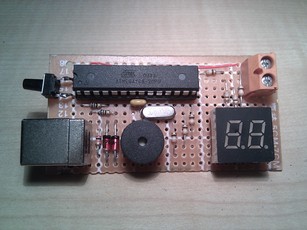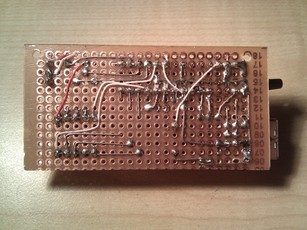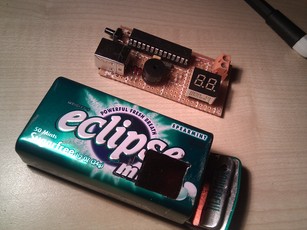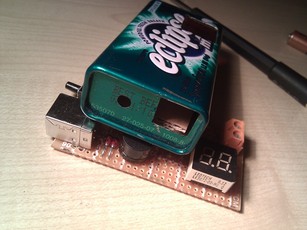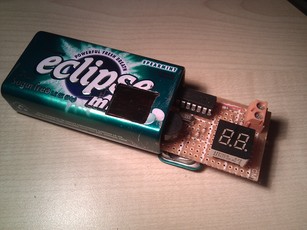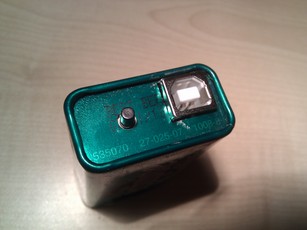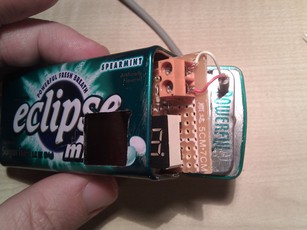Morse key USB keyboard - Hardware
Overview
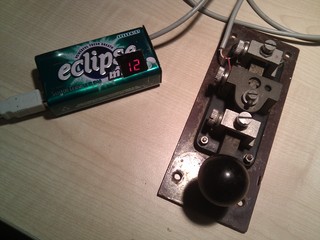 The Morse Keyboard is based around an ATMEGA168 microcontroller. The V-USB library is
used to provide direct control of USB, eliminating the need for any other active components.
A dual 7 segment display is also attached to the IO pins. Also, the Morse key and
an additional button (to enable 'learning') is attached. There is really nothing
else to it.
The Morse Keyboard is based around an ATMEGA168 microcontroller. The V-USB library is
used to provide direct control of USB, eliminating the need for any other active components.
A dual 7 segment display is also attached to the IO pins. Also, the Morse key and
an additional button (to enable 'learning') is attached. There is really nothing
else to it.
A regular USB socket is used to connect directly to a host.
The display is connected directly to some IO pins (via resistors).
The morse key connects via resistors to an IO pin.
A button on board is used to start 'learning' mode. When pressed, you enter the morse "-.-.-" and the firmware starts off with the speed you tapped this code with.
A mini speaker provides a side tone so you can hear what you're tapping. This can be disabled in software.
Below is a somewhat hastily drawn schematic.
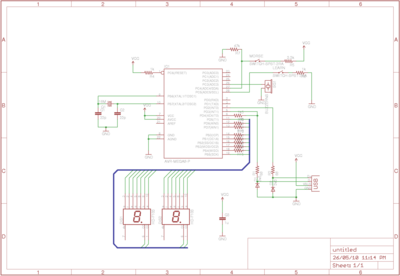
Parts list
Substitute values also listed where tolerance is not critical. Generally, only the crystal and zener diodes are critical, the rest can be 10-20% out.| Qty | Description | Notes |
|---|---|---|
| 1 | ATMEGA168 MCU | At least -16 MHz rated |
| 1 | 16MHz crystal | |
| 2 | 22pf capacitor | XTAL loading (15p-27p ok) |
| 2 | 3.3v zener diode | USB clamping |
| 2 | 68 ohm resistor | USB limiting |
| 1 | 1.5k ohm resistor | USB pullup |
| 1 | 1uF capacitor | VCC Bypass (0.1 - 1uF ok) |
| 1 | 47k ohm resistor | Morsekey pulldown (22k-68k ok) |
| 1 | 3.3k ohm resistor | Morsekey pullup (1k - 4.7k ok) |
| 2 | 1k ohm resistor | Reset pullup Learn pulldown. (1k-4.7k ok) |
| 7 | 270 ohm resistor | LED current limiting (330k ok) |
| 1 | PCB mount speaker | beep beep beep |
| 2 | 7-segment display | Code supports common anode or common cathode. |
| 1 | USB B socket | |
| 1 | Morse key, single contact | |
| 1 | 2-way screw headers | To wire in morse key |
PCB
Whilst I'm no stranger to etching my own boards, I decided to go the easy route here, and used prototype board, soldering links between components. It's easily reproducible and still fits in the case.Components
I elected to go small but not tiny. Most of the components are thru-hole, but a few are SMD, especially where adjacent pads are used. Resistors are 1/8W, which are much easier to fit on a small board than the larger 1/4w ones. And they were super-cheap from ebay for a bag of 5000 mixed types. The display was found from my junk box.Case
The case is an Eclipse mint tin. Like Altoids, these come in a peoper metal tin which lends itself well to this project. A little cutting with a mini dremel tool allows for all the various sockets, button and display.Morse key
A real morse key. Accept no substitutes.I can be reached at bb @ cactii . net
